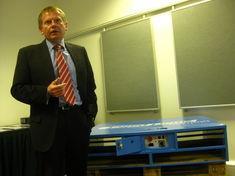
As the pressure is turned up on pesticide use in the fields, a new residue-free product which harnesses the Earth’s most powerful natural disinfectant and oxidant, ozone has been launched onto the market, to prevent post-harvest spoilage.
The smartpallet - a pallet for post-harvest storage and transit use was unveiled at East Malling Research Centre by producers biofresh last week. This product harnesses the power of gaseous ozone to prevent the spread of disease and rots.
As concerns over waste and pollution grow, biofresh hope that their ozone storage units, which range in sizes suited to a range of wholesale and transit applications, will become integral to the industry via the suppression of microbial spoilage, and thus waste.
The biofresh systems also cleanse contaminated air, inhibit fungal development and prevent fungal sporulation without risk of leaving chemical residues. They can now be used in both warehouses and containers taking the form of storage units or pallets.
Professor Jerry Barnes of Newcastle University, who has worked with ozone for over twenty years, told FPJ: “biofresh provide a solution at all points in the supply chain, treatment efficacy depends on how far the produce is travelling and how long it will be in store, but the low, safe, accurately-monitored levels of ozone can be extremely effective.
“The transit environment was a market biofresh always wanted to address. It’s important for wholesalers that produce arrives safely and disease-free and if there is one infected piece of fruit in a carton the spread of the disease can be very quick resulting in significant spoilage” he said.
Although ozone generators already exist on the market, biofresh products offer precise control at prescribed concentration ranges, generators adopted in the U.S. often generate uncontrolled levels which invariably grossly exceed the biofresh recommended levels of between 80 and 160 parts per billion.
Ozone doesn’t cure lesions, rot or fungus already inherent in the fruit, but it has been shown to effectively stop it spreading whilst in the storage area..
Mercedes Pedreño, research scientist for biofresh, said: “It depends which fruit you’re dealing with to decide which and how many of the supply chain points the technology should be implemented in.
“The ozone should be introduced as close to the fans in a store or container as is possible to prevent the creation of ‘hotspots’.”
Concerns were raised over the products’ effectiveness on stored citrus. It is proven to work well with most fruit from kiwis to strawberries, but Barnes conceded that of the benefits seen “citrus may not be top of the list”. He said: “We began our research over 15 years ago and have tested all kinds of produce at all levels and this is the most accurate and successful range of machines for the purposes targeted.
“Shelf-life is obviously a key factor but in a market like, say, strawberries where the fruit is in store for a very short time a product like this is perfect.
“Consumer interests in pesticide contamination of fresh produce are growing and I can see a point where every home has a biofresh ozone drawer in the refrigerator,” he said.
The biofresh products are not subject to Pesticide Safety Directorate (PSD) regulations because it is generated on site and does not need a license unlike ethylene scrubbing which is often used in the industry.
Ozone is already used in other industries including sanitisation of food and drink, laundry and paper manufacture, it is second only to rocket fuel in terms of oxidant power and is a ‘green’ gas in that it leaves no detectable chemical residues and employs a generator requiring no chemical input.
The event took place at the East Malling Research Station in Kent, the Centre looks at a wide range of horticultural research including the breeding of new rootstocks, the extension of the life of stonefruit and improving the water use efficiency of a number of crops.



